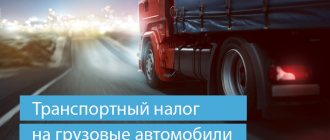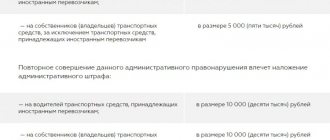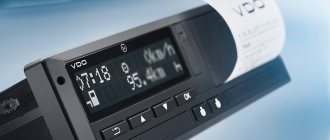For what reason did the question of introducing the Plato system arise?
Every year the flow of cars moving on the roads of our state is increasing. The more vehicles there are, the more damage is caused to the road surface. It is not without reason that heavy vehicles cause particular harm to the integrity of the roadway. It is their tires that wear out the road surface the most and it is under their weight that ruts are formed, into which cars then end up. And given that trucks often come with violations of loading standards, the damage is even more serious.
Therefore, repairs on such highways are required more often. There are not enough budgetary funds to fully maintain roads in good condition, so a transport tax is collected at the regional level. But federal roads do not receive such an infusion of funds in the form of a transport tax.
ATTENTION !!! In order to receive additional funds, the “Platon” fee system was created on behalf of the Government of the Russian Federation (its name was derived from the words “ton” and “fee”). Similar systems operating in many developed European countries were taken as a model (for example, in Austria, which was the first in the European Union to implement a similar idea).
The introduction of this fee system gave rise to a wave of protests, including large-scale ones. But, nevertheless, “Platon” continues to operate, since its launch has reduced the burden on the federal budget. Some cities even have billboards with information provided by the Federal Road Fund about which roads and to what extent have been repaired with proceeds from Platon.
The Wikipedia website indicates that revenues from the work “Plato” in 2016 reached almost 22 billion rubles. With the increase in tariffs and the increasing inclusion of road freight carriers in the system, budget revenues correspondingly increase.
History and background of system development
The Platon system was developed by analogy with foreign programs. One of the main prerequisites for the implementation of the system is the unsatisfactory condition of federal public roads and the lack of budget funds for their restoration. The Russian government has come to the logical conclusion that the main damage to asphalt pavement is caused by multi-ton trucks. They wear out the road surface and push through the “cushion” of crushed stone and sand, which causes the formation of “dents” and ruts on the asphalt.
Read also: Which products cannot be returned
There were not enough federal budget funds to constantly restore “worn out” roads. The program developers decided to use the funds raised to repair and build new routes.
System in figures and facts
The first country to introduce a system for collecting funds from heavy trucks is Austria. In Russia, the program began to function only in the fall of 2015. The introduction of the Platon system caused a lot of outrage among drivers and owners of multi-ton vehicles. In order to reduce the financial burden on them, it was decided to exempt the owners of heavy trucks from paying transport tax if the amount of contributions to the system exceeded the tax accruals for the current billing period.
However, starting from 2021, this relaxation measure has been abolished. Now owners of multi-ton trucks will have to pay both types of mandatory contributions.
Essence "Plato"
The main operating principle of this system is to charge a fee for each kilometer that a heavy-duty vehicle travels along the federal highway. This is possible by installing on board a truck or other vehicle device connected to the GLONASS or GLONASS/GPS system (depending on the model). The on-board GLONASS device, coupled with a complete road map and vehicle database entered into the system, allows you to quickly track the route of a heavy truck for the most accurate calculation of the toll amount.
The system has its own official website. The specified Internet resource is located at www.platon.ru. Here you can find a lot of necessary information regarding the toll system, including the latest news.
Payment options within the system
By registering on the site, the car owner automatically registers a personal account with which payments will be made in the system. Data is transferred to the account from the on-board device, and funds are automatically debited for each kilometer of distance traveled.
You can top up your account in the Platon system using a bank card or electronic means of money systems (Yandex, WebMoney, Qiwi).
If a trucker is driving along a pre-designed route and does not intend to deviate from it, it is possible to purchase a route map with the exact route of the upcoming journey and the cost of the entire trip. In this case, funds will no longer be debited in real time.
Regulation of the Plato system
The legal aspects of the existence of “Plato” are set out in Decree of the Government of the Russian Federation No. 504 of June 14, 2013. This document sets out the basic rules by which tolls are collected for the use of federal highways, provides basic concepts and other important issues regarding the existence of this system.
Also, some issues are addressed in Federal Law No. 275-FZ of November 8, 2007 and in Government Order No. 1662-r of August 29, 2014.
The Platon system is supervised by the Federal Road Agency (Rosavtodor). The full cycle of maintenance and modernization, including collection of funds, is carried out by RT Invest Transport Systems LLC.
Connection to the Platon system
To add a vehicle to the database, it must be registered in the toll collection system.
There are three possible ways:
- when the cargo carrier issues a so-called route card at self-service Terminals;
- on the portal "Platon";
- in the Centers where information support is provided to system users.
A personal account is created for each user with a unique login and password. The personal account gives the user ample opportunities: adding a new car to the database, editing the personal data of the vehicle owner, replenishing an account to pay fees, registering a new route card, sending requests to the Platon management company, etc. There is also a Mobile application "Plato".
How to pay the driver
For drivers, payment for travel is possible in, through the system’s website and through terminals. In addition, you can pay for travel through the on-board device and route card; these are two options for controlling the movement of the car.
The on-board unit is a small device that can be easily installed on the cockpit windshield. But the device must not be placed in the heated area of the glass.
2 million of these devices will be distributed free of charge. To receive it, you need to register at the system office, sign an agreement and receive the device.
Information from the device is continuously transmitted to the system center; Money for travel on federal roads is automatically debited from your account.
There is also a payment method using a route card. The card can also be issued at the Platon system office; it is also possible to issue it through the terminal. The map indicates the points of departure and destination, intermediate points - if available. Information about the car and driver is entered to control movement.
There is a difference in using an on-board unit compared to a route map. The map assumes movement along a fixed route, the device allows you to select and adjust the route. Sometimes such benefits come at a price, especially in case of traffic jams.
The Plato on-board device will be issued free of charge
Methods of compensation for damage caused by heavy vehicles to federal highways
The above compensation can be made in two ways:
- in the form of an advance payment;
- as a payment according to the meter according to the kilometers traveled.
When making an advance payment, a route map is first generated, which indicates which routes the vehicle will take, and then payment for the entire route is made.
When paying according to the distance traveled, you do not need to pay for the entire route at once; it can be paid in installments. The user's personal account must have an amount sufficient to travel to the next tracking frame. The second method is most often used by representatives of small transportation businesses.
In both cases, the vehicle is re-registered in the system before each trip. But the difference between the two methods is not only the amount initially deposited into the account. The second method allows you to quickly change your route without fear of being fined. But the advance method also has its advantages: it allows you to pay for several upcoming trips a couple of months in advance.
The cost of travel for 12 tons per 1 km is 1 ruble 90 kopecks.
Calculation of payment and methods of making charges
The amount of mandatory payments depends on the kilometers traveled by the heavy truck. For the calculation, a single cost of 1 kilometer is established. This tariff has changed several times and is:
- When implementing the Platon system - 3.5 rubles per 1 km.
- In the spring of 2015, the tariff was revised, and the cost of 1 km increased to 3.73 rubles.
- In the autumn of the same year, the Government established a “preferential” coefficient of 0.41. Thus, the cost of 1 km was 1.53 rubles.
- In March 2021, the Government planned to increase the tariff to 3.06 rubles, but this change was not accepted and the cost remained unchanged.
- In the spring of 2021, the “preferential” coefficient was revised. After the changes, it was 0.51, and the cost of 1 km increased to 1.91 rubles.
Nuances of the Plato system
In 2021, the amount of the mandatory payment under Plato is calculated using the formula: 3.73 * 0.51 * P, where P is the distance traveled by the truck along the federal highway, measured in kilometers.
Payment between the owner of the truck and the operator of the Platon system is made by non-cash method. If an on-board computer is installed in the cabin of a heavy truck, then when paying, funds are automatically debited from the individual personal account of a specific vehicle. If a route card was issued, then payment is made by bank transfer using the operator’s details.
Read also: Punishment for leaving the scene of an accident
It is also possible to deposit funds through terminals, a mobile application or a personal account.
How to control the movement of a heavy vehicle
The movement of a heavy-duty vehicle is controlled using on-board devices. Shippers immediately ask the question: “What is this and how much does it cost to install?” This is a technical tool that uses one of two navigation technologies: either GLONASS or GLONASS/GPS.
Receiving and further use of the device is absolutely free for the truck owner. To install it on board, registration in the system and the conclusion of an agreement on use with the company managing the system, i.e. with the above-mentioned “RT-ITS”. To conclude a contract and receive a navigation device, you must contact the Center, where information support for users is provided.
ATTENTION !!! Briefly about how monitoring the movements of heavy vehicles works. To track the route of cars along all federal highways, special frames with an electromagnetic field are installed (at the moment there are almost 500 of them). When driving through such a frame, mileage data will be read. Such data is promptly sent by the system to the settlement center, and funds are debited from the cargo carrier’s personal account.
Service for the navigation tracking device is also free of charge, except in cases where the device was operated in violation of the instructions. Replacement of failed technical equipment is also free of charge. Upon termination of the cargo carrier's activities or in other cases of termination of the contract, the on-board unit must be returned.
Operating principles of the system
"Platon" automatically collects, stores, processes and promptly transmits accurate data on the movement of vehicles weighing more than 12 tons on federal highways. To drive a multi-ton truck on federal highways, the owner of the truck must register himself and the vehicle in the Toll System Register.
Satellite navigation equipment allows you to collect information about the movement of the truck, which is then processed automatically. At the Information Support Center, each truck owner can receive an on-board device that can, using GLONASS/GPS, record the coordinates of a moving vehicle. To do this, you must enter into a free use agreement with the operator.
Important information! The movement of multi-ton vehicles without an on-board unit is permitted only if you have a pre-issued route map.
All data on the movement of a multi-ton vehicle is transmitted via cellular communication to the Processing Center, and based on the information received, the amount of payment for travel on federal roads is automatically calculated. If freight vehicles do not travel on a federal road or travel along toll sections of federal highways, these sections of the route are not included in the calculation of the toll.
When a vehicle passes under the frame of a special stationary control system:
- if an on-board device is installed in the car, the availability of money in the current account is checked;
- If there is no on-board device, the system checks for the presence of a route map.
Payment for the movement of a truck is charged from the personal account of the vehicle owner automatically. Within the framework of the Platon system, several methods of paying for travel have been developed: the advance method, for the used mileage and using hanging frames. On sections of federal roads that are not equipped with stationary monitoring frameworks, specially equipped vehicles of the “Platon” system are patrolled.
Advance payment scheme and postpayment
Paying for the passage of multi-ton trucks on federal roads can be carried out as follows:
- before the truck starts moving on federal highways;
- in post-payment mode, with the amount of the contribution approved by the Government of the Russian Federation.
Read on topic: How to polish headlights
With an advance payment system, the owner of a multi-ton truck must deposit the required amount of money into the account immediately before the trip. You can pay the amount only for 1 trip or for several, then it will be considered an advance for the next trips.
Payment for the actual distance traveled
Paying for the distance traveled by a truck is the best way, since in this case the risk of overpayment is minimized. In this case, the owner of a heavy vehicle pays a fee to compensate for damages for the route taken along the federal highway. At the same time, he can choose a payment calculation option that is convenient for him:
- Installation of the on-board device. The debiting of money from the owner's account is carried out automatically, which avoids inaccuracies due to the influence of the human factor.
- Preparation of a route map (one-time). This payment method involves paying a fee for 1 route.
Important information! Until February 2021, the tariff for 1 km traveled by a multi-ton truck was 1.5 rubles. From March 2021 until the end of 2021 it is 3.06 rubles.
Use of satellite navigation systems
Monitoring the location of vehicles that weigh more than 12 tons is carried out using on-board devices. They provide excellent reception of signals from GPS and GLONASS navigation systems. The on-board device allows you to perform calculations automatically. To receive an on-board device, the car owner must provide the system operator with a package of documents and enter into a free use agreement.
After installing a functional on-board unit in a truck, when the vehicle enters a federal highway, the system determines the geographic coordinates. This happens with the help of well-known navigation satellite systems GLONASS and GPS. The received information is transmitted at certain intervals through the cellular operator to the Data Processing Center.
Traffic monitoring: identification of vehicles weighing over 12 tons
The process of paying tolls for travel on various federal highways can be carried out by the following control systems:
- Frames with attachments. Stationary structures that are installed above a federal road.
- Mobile control. Vehicles equipped with special equipment monitor sections of the road where mounted frames are not placed.
The Platon system was developed and introduced to attract funds for the development of the Russian road sector. Owners of vehicles weighing more than 12 tons must be registered in the system and pay a toll for causing damage and wear to federal highways. The tax is calculated according to a specific scheme and can be levied in different ways. If trucks move along toll roads, then the Platon system fee is not subject to payment.
Limits of liability for attempts to bypass the system
The most common examples of attempts to bypass the Platon system and violations for which administrative responsibility is established are:
- in the absence of an on-board device that tracks movement;
- in case of deliberate disconnection of the above device, as well as in case of its breakdown without notifying the management organization;
- in the event that the user’s personal account is empty and there is no way to write off funds, and the vehicle continues to follow the federal highway (when paying by meter. With advance payments, the vehicle can continue to follow the route with the condition of leaving it unchanged.
The user simply subsequently deposits the missing amount into his personal account);
- when hiding a route change from the management organization, etc.
IMPORTANT !!! All these violations fall under Article 12.21.3, which establishes liability for this in the amount of 5 thousand rubles for the first offense, and up to 10 thousand rubles for a repeated offense.
Drivers of vehicles of foreign carriers, as well as citizens of the Russian Federation who are the owners of vehicles with the help of which these offenses were committed, are held liable under this article. Drivers of cars owned by Russian freight carriers are not subject to liability under this article, unless the driver is also the owner of the car.
Violation of rules and prescribed fines
Failure to fulfill obligations to make mandatory payments is a violation of No. 257-FZ and is punishable by administrative fines. Violations also include improper operation of calculation equipment, namely:
- Disabling the on-board computer.
- Installation of unlicensed equipment.
- Refusal to install devices.
- Deviation from the planned route without making appropriate changes to the equipment.
- Working with faulty or malfunctioning equipment.
- Traveling without obtaining a route map.
Read also: Mandatory certification
For any of the listed violations, a fine of 5,000 rubles is imposed. The penalty is issued to the owner of the heavy truck, provided that he is a citizen of Russia.
Note: if the car is registered to a foreign citizen, then the obligation to pay a fine rests with the driver of such a car.
If a violation is detected again, you will have to pay a penalty, the amount of which is already 10,000 rubles.










